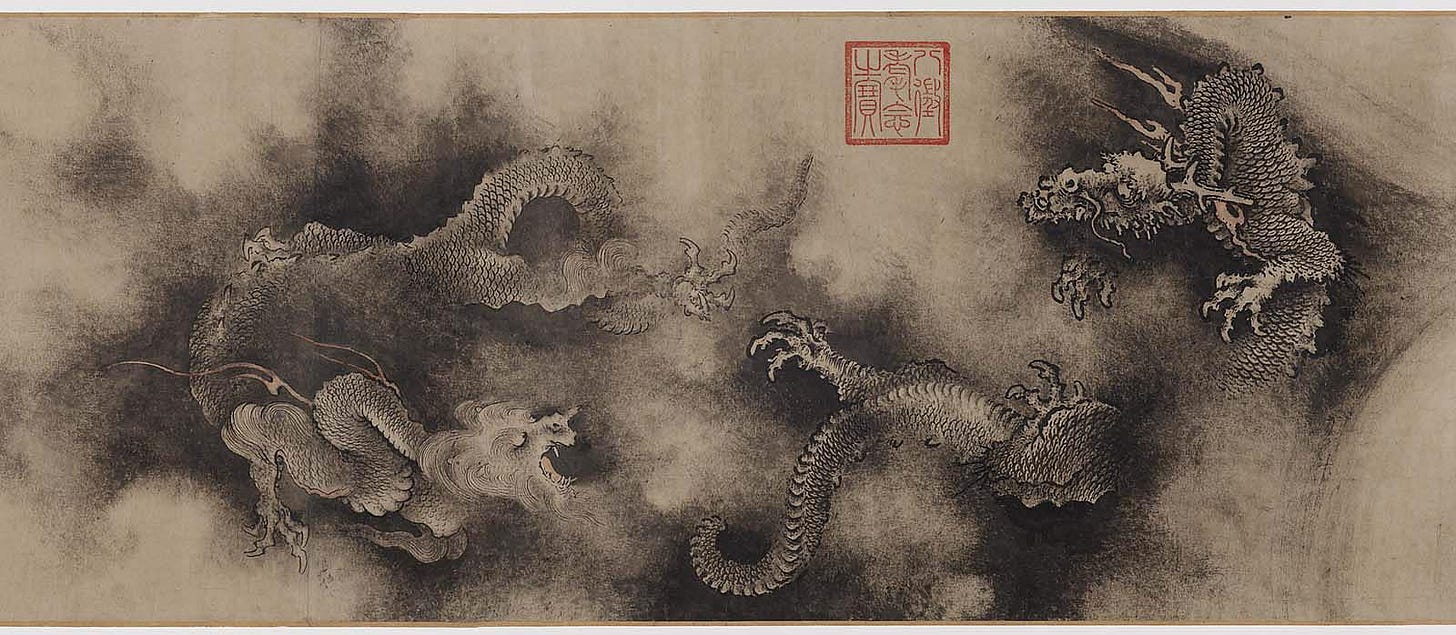Water gives life to the ten thousand things and does not strive.
It flows in places men reject and so is like the Tao.
In dwelling, be close to the land.
In meditation, go deep in the heart.
In dealing with others, be gentle and kind.
In speech, be true.
In ruling, be just.
In business, be competent.
In action, watch the timing.
No fight: No blame.
Tao Te Ching by Lao Tzu (translation by Gia-fu Feng and Jane English)
DRAGON
Telluric, arrogant and expansive creature; an universal symbol present in most Eastern and Western cultures, classical and primitive. The dragon incarnates the internal beast, the instinctive impulses that are part of human nature. It is an ambivalent image, it usually appears as a winged serpent that transmits as much destructive chaos as the original harmony between heaven and earth. It is also depicted with no wings and emerging from earth's depths with an amphibious body. The worm, the crocodile, and even the lion, are intimately related with the dragon. Sometimes it appears with more than one head to multiply its diabolical aspect as the red dragon of seven heads of the Apocalypse. It is a fundamental symbol of Chinese culture, an emblem of imperial power and it is associated with power and the sublimation of perversion. Chen Rong, a 13th-century Sung dynasty painter, attempted to capture in the Nine Dragons —a memorable ink drawing 15 meters wide— the aquatic nature of Tao. In many legends the dragon appears as the enemy to beat and represents the rite of passage par excellence. Apollo, Perseus and Siegfried defeat the dragon. The legend of St. George is the paradigm of the internal struggle between matter and spirit that is solved by a transformation: the dragon does not die, but becomes a rose. Dissolving —accepting the animal rather than rejecting it— is the secret of the transformation. The mercurial dragon of alchemy is light and dark, poison and medicine. We must understand that paradox and conflict are the essence of the dragon and archetypal stories built around it show a way of accessing the central, authentic and sacred core of every human being that Jung called the Self. It is fascinating how the psyche can create images out of nothing and the dragon is an incomparable example to understand how thousands of years after inventing itself continues to serve as a symbol to transmit something inexpressible with words.
“Fairy tales do not tell children the dragons exist. Children already know that dragons exist. Fairy tales tell children the dragons can be killed”
G.K. Chesterton
La bondat suprema és com l’aigua,
que tot ho nodreix sense pretendre-ho.
S’acontenta amb els llocs inferiors que la gent menysprea.
Per això és com el Tao.
Al viure, viu a prop del terra.
Al pensar, estigues en la simplicitat.
En el conflicte, sigues considerat i generós.
Al governar, no intentis controlar.
Al treballar, fes-ho amb el que gaudeixis.
En la vida familiar, estigues plenament present.
Quan t’acontentis en ser simplement tu mateix,
i no et comparis ni competeixis,
tothom et respectarà.
Tao Te Txing de Lao Tzu (traducció de Manuel Garcia i Sanz)
DRAC
Criatura tel·lúrica, altiva i expansiva; es tracta d’un símbol universal present en la majoria de cultures orientals i occidentals, clàssiques i primitives. El drac encarna l’animal desbocat, les pulsions instintives que formen part de la naturalesa humana. Imatge ambivalent, sol aparèixer com una espècie de serp amb ales que transmet tan el caos destructiu com l’harmonia original entre el cel i la terra. També se’l representa sense ales i emergint de les profunditats de la terra amb un cos amfibi. El cuc, el cocodril, i fins i tot el lleó, hi estan íntimament lligats. A vegades apareix amb més d’un cap per multiplicar el seu sentit diabòlic com el drac vermell de set caps de l’Apocalipsi. A Xina és un símbol d’àmplia difusió, emblema del poder imperial i lligat a la força i a la sublimació de la perversió. Chen Rong, pintor de la dinastia Sung del segle XIII, va intentar capturaren els Nou Dracs —un memorable dibuix en tinta de 15 metres d’amplada—la naturalesa aquàtica del Tao. En multitud de llegendes apareix com l’enemic a batre i representa la prova iniciàtica per excel·lència. Apol·lo, Perseu i Sigfrid derroten el drac. La llegenda de Sant Jordi és el paradigma de la lluita interna entre matèria i esperit que es resol amb una transformació: el drac no mor, sinó que es converteix en rosa. La dissolució —acceptar l’animal en lloc de rebutjar-lo— és el secret de la transformació. El drac mercurial de l’alquímia és llum i foscor, verí i medicina. Hem d’entendre que la paradoxa i el conflicte conformen l’essència del drac i els relats arquetípics construïts al seu voltant manifesten una via d’accés al nucli central, autèntic i sagrat de tot ésser humà que Jung anomenava com el self, el sí-mateix. El més fascinant de la psique és la capacitat per crear imatges del no-res i el drac és un exemple incomparable per entendre com milers d’anys després de donar-se vida a sí mateix segueix servint de símbol per transmetre allò que seria inexpressable amb paraules.
“Els contes de fades no diuen als nens i nenes que existeixen els dracs. Ja ho saben que existeixen els dracs. Els contes de fades diuen als nens i nenes que els dracs poden ser vençuts”
G.K. Chesterton









